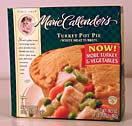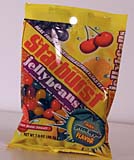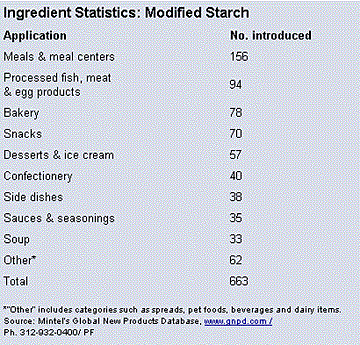Here is quick refresher on modified food starches:
In breadmaking, both wheat protein (especially gluten), and starch play an important role in the formation of the texture of the dough and bread. Starch, about 75-85% of flour, dilutes the gluten, interweaves with gluten and absorbs water from the gluten by gelatinization.
It then provides a bread structure permeable to gas, so that the bread does not collapse while cooling. As temperature increases and starch gelatinizes, starch competes with other components for the water available in the system. Thus, starch “sets” the structure of baked product systems. Studies reveal that modified starches, which were developed to suppress undesirable properties of native starches, also affected the properties of dough and quality of bread.

Gravitating Toward Gravy
Marie Callendar’s Turkey Pot Pie (MC Retail Foods, Omaha, Neb.), like a number of its products this last year, was reformulated to contain more generous amounts of meat and vegetables. Its gravy contains a highly functional modified corn starch.“Waxy maze starches that are moderately crosslinked and substituted often are used in frozen food applications,” says Mike Augustine, director of food ingredient applications, Tate & Lyle/A.E. Staley, Decatur, Ill. This enables them to impart freeze-thaw stability, withstand processing, and maintain a smooth texture and bind water when reheated by the end consumer.
Although Mintel’s GNPD lists meals and meat products as the largest sectors requiring modified starches, their actual functions vary. Modified starches are used to bind water for improved yields and reduced purge in processed meats. Their ability to gel makes them useful in reduced fat products. And, the binding properties of starch, improved through oxidation, help batters and coatings adhere to poultry and fish products.

Stabilizing Influence
Hidden Valley Ranch (parent company Clorox, Oakland, Calif.) introduced several toppings and dressings last year in a no-mess, easy-to-squeeze bottle that stores “upside down.” However, the use of modified starch in this product's formulation likely has less to do with a clever and convenient package than with the ingredient's stabilizing properties.Starches typically need to assist with three issues in dressings, informs Augustine.
As an oil-in-water system, the starch stabilizes the emulsion by increasing product viscosity. Intermediate viscosity starches, while not a fat replacer, per se, also provide fat-like characteristics. Hydrolyzed starches and/or maltodextrin—the third ingredient listed on this label after water and oil—also add to the product's fuller fat sensory experience.
Although not certain, the particular starch used is likely to be a waxy (high amylose) starch that is moderately cross linked with a moderate to high level of substitution. Crosslinking increases stability to acid, heat treatment, and shear forces, the third issue with dressings.
www.hiddenvalley.com

Straightforward Starch
Masterfoods USA (parent company M&M/Mars, Hackettstown, N.J.) recently introduced Starburst Jellybeans with a new green apple flavor. Its ingredient legend lists “sugar, corn syrup, food starch-modified, apple juice from concentrate, less than 1.5%: citric acid, confectioner's glaze, artificial and natural flavors, gum acacia.”
The use of modified food starches in confectionery is
fairly straightforward, states Augustine. Generally, starches that require minimal heat processing are used. They often are partially hydrolyzed, thin-boiling starches of lower viscosity when heated, allowing them to be used in high concentration in a product. When cooled, they gel and provide the “chewy candy” texture.
www.starburst.com/cai.html
www.m-ms.com -(Editor's note: Good ad)

Heaviness Optional
Kraft Foods International (Rye Brook, N.Y.) recently introduced Fat Free Pudding Snacks to its Jell-O Sundaes line. In chocolate fudge and caramel flavors, they have 100 calories per 113g snack serving. The ingredient statement reads “skim milk, water, sugar, modified food starch, cocoa processed with alkali, contains less than 0.5 percent of natural and artificial flavor, salt, sodium stearoyl lactylate (for smooth texture), sodium alginate, sodium phosphates, artificial color, vitamin A palmitate, vitamin D.”
“In puddings, what often is used is a modified waxy maze starch that is moderately to highly crosslinked—depending on how much heat processing the product undergoes,” says Augustine. If aseptically processed, the thickener must withstand a fair amount of heat. A starch with some substitution provides a lighter, creamy texture. A waxy dent or tapioca starch provides a heavier mouthfeel, he adds.
www.kraftfoods.com/cgi-bin/product.cgi?PRODUCT_ID=69
www.kraftfoods.com/jell-o/jell-o.html

Mastering Miscellaneous
As of the writing of this column, the GNPD lists some 30 individual items or product lines in the "Snack Bars, Snack Mixes & Energy Bars" sub-category that contain modified starch.In January of this year, Quaker Oats (Chicago, parent company Pepsico) released a Bites version of its Fruit & Oatmeal Cereal Bars that uses modified food starch in its formula to control texture and taste. It joins a respected group of nutrition/energy bars utilizing this ingredient such as PowerBar (Berkley, Calif., parent company Nestle USA), that added a new caramel apple flavor to its Sugar-Free Protein Plus bar line.
Dairy applications include items such as Wells' Dairy (Le Mars, Iowa) new pineapple, orange, banana-flavored Blue Bunny Lite 85 Sugar Free yogurt, to Publix's (Lakeland, FL.) newly-introduced Tangerine Dream Light Ice Cream, under its private label line. Sold in the Southeast, the starch, along with stabilizers, provides a creamy texture to a product that is lower in fat and calories than regular ice cream.
www.quakeroats.com
www.powerbar.com
Sidebar: Modifying for Function
Consumers expect to have their food when and wherever they want. Manufacturers strive to meet this demand with an array of processed beverages and foods that must withstand rigorous processing and storage conditions.Starch forms the backbone of many of these formulations. Generally consisting of linear amylose and branched amylopectin molecules, starch is primarily located within water-insoluble granules in plants. The physical and chemical properties of native starches vary, depending on plant species and variety.
Corn, rice, wheat, sorghum, potatoes and tapioca are common plant sources. Formulators can choose among starches from these sources in their effort to optimize a product's texture, taste and stability. Sometimes, a native starch, that is, one unmodified from its original form, does not possess the needed functionality. Modification, whether physical, or the result of reactions with the starch molecules' hydroxyl groups (-OH), improves starch properties.
For example, starch derivatives, created when a monofunctional chemical reacts with the hydroxyl group, increase paste clarity and reduce gelation under freeze-thaw conditions. Oxidation increases starch paste viscosity and clarity, and also decreases its ability to gel. Cross-bonding helps starch maintain high viscosity under acidic and high shear conditions. An acid-modified starch results in one that produces very strong gels.
Using Mintel International's Global New Products Database, 663 products or product lines containing modified starch are found (introduced in North America in 2001). Some 156 of these are meals or entrées, many with gravy or sauce components.
—Claudia D. O'Donnell, Chief Editor
Links
- “Food Science 101”
- International Starch Institute website, Denmark
- IPCS Inchem — Chemical Safety Information from Intergovernmental Organizations; type in “starch” on homepage search field
- May 1999 Federal Register notification allowing use of modified food starch in certain meat products
- Dictionary
- Glossary
- Iowa State University press release on a modified starch that could replace sugar